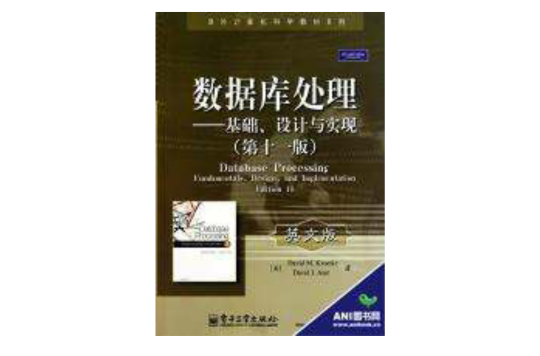內容簡介
《資料庫處理:基礎、設計與實現(第11版)(英文版)》從基礎、設計和實現三個層面介紹資料庫處理技術,內容全面翔實,既包括資料庫設計、資料庫實現、多用戶數據處理、數據訪問標準等經典理論,也包括商務智慧型、XML和NET等最新技術。《資料庫處理:基礎、設計與實現(第11版)(英文版)》在內容編排和寫作風格上新穎,強調學習過程中的樂趣,圍繞兩個貫穿全書的項目練習,讓讀者從一開始就能把所學的知識用於解決具體的套用實例。
《資料庫處理:基礎、設計與實現(第11版)(英文版)》每章都有豐富的習題,可作為高校本科生或研究生的資料庫課程的雙語教材,同時也是一本很好的專業參考書。
編輯推薦
《資料庫處理:基礎、設計與實現(第11版)(英文版)》:提前介紹了SQL查詢使用“螺旋方法”進行資料庫設計為數據建模和資料庫設計使用了一種通用的信息工程“鴉腳”E-R模型詳細探討了實際規範技術中的特定範式使用了最新的DBMS技術:Microsoft Access2007,Microsoft SQL.Setver 2008,Oracle Database 11g,MySQI 5.1基於廣泛使用的Web開發技術,創建了Web資料庫套用簡介了商務智慧型系統探討了數據倉庫和在線上分析處理資料庫設計中使用的維資料庫概念。
作者簡介
作者:(美國)克羅恩克(David M.Kroenke) (美國)奧爾(David Auer)
圖書目錄
Preface xvii
PART 1 GETTING STARTED
Chapter 1:Introduction
Chapter Objectives
The Characteristics of Databases
A Note on Naming Conventions
A Database Has Data and Relationships
Databases Create Information
Database Examples
Single-User Database Applications
Multiuser Database Applications
E-Commerce Database Applications
Reporting and Data Mining Database Applications
The Components of a Database System
Database Applications and SQL
The DBMS
The Database
Personal Versus Enterprise-Class Database Systems
What Is Microsoft Access?
What Is an Enterprise-Class Database System?
Database Design
Database Design from Existing Data
Database Design for New Systems Development
Database Redesign
What You Need to Learn
A Brief History of Database Processing
The Early Years
The Emergence and Dominance of the Relational Model
Post-Relational Developments
Summary
Key Terms
Review Questions
Project Questions
Chapter 2:Introduction to Structured Query Language
Chapter Objectives
Cape Codd Outdoor Sports
The Retail Sales Data Extraction
RETAIL_ORDER Data
ORDER ITEM Data
SKU_DATA Table
Data Extracts Are Common
SQL Background
The SQL SELECT/FROM/WHERE Framework
Reading Specified Columns from a Single Table
Reading Specified Rows from a Single Table
Reading Specified Columns and Rows from a Single Table
Submitting SQL Statements to the DBMS
Using SQL in Microsoft Access 2007
Using SQL in Microsoft SQL Server 2008
Using SQL in Oracle Database 11g
Using SQL in Sun Microsystems MySQL 5.1
SQL Enhancements for Querying a Single Table
Sorting the Results
SQL WHERE Clause Options
Combing the SQL WHERE Clause and the SQL ORDER BY Clause
Performing Calculations in SQL Queries
Using SQL Built-in Functions
SQL Expressions in SQL SELECT Statements
Grouping in SQL SELECT Statements
Looking for Patterns in NASDAQ Trading
Investigating the Characteristics of the Data
Searching for Patterns in Trading by Day of Week
Querying Two or More Tables with SQL
Querying Multiple Tables with Subqueries
Querying Multiple Tables with Joins
Comparing Subqueries and Joins
Summary
Key Terms
Review Questions
Project Questions
Marcia's Dry Cleaning
Morgan Importing
PART 2 DATABASE DESIGN
Chapter 3:The Eelational Model and Normalization
Chapter Objectives
Relational Model Terminology
Relations
Characteristics of Relations
Alternative Terminology
Functional Dependencies
Finding Functional Dependencies
Keys
Normal Forms
Modification Anomalies
A Short History of Normal Forms
Normalization Categories
From First Normal Form to Boyce-Codd Normal Form
Eliminating Anomalies from Functional Dependencies
Eliminating Anomalies from Multivalued Dependencies
Fifth Normal Form
Domain/Key Normal Form
Summary
Key Terms
Review Questions
Project Questions
Marcia's Dry Cleaning
Morgan Importing
Chapter 4:Database Design Using Normalization
Chapter Objectives
Assess Table Structure
Designing Updatable Databases
Advantages and Disadvantages of Normalization
Functional Dependencies
Normalizing with
Choosing Not to Use BCNF
Multivalued Dependencies
Designing Read-Only Databases
Denormalization
Customized Duplicated Tables
Common Design Problems
The Multivalue, Multicolumn Problem
Inconsistent Values
Missing Values
The General-Purpose Remarks Column
Summary
Key Terms
Review Questions
Project Questions
Marcia's Dry Cleaning
Morgan Importing
Chapter 5:Data Modeling with the Entity-Relationship Model
Chapter Objectives
The Purpose of a Data Model
The Entity-Relationship Model
Entities
Attributes
Identifiers
Relationships
Maximum Cardinality
Minimum Cardinality
Entity-Relationship Diagrams and Their Versions
Variations of the E-R Model
E-R Diagrams Using the IE Crow's Foot Model
Strong Entities and Weak Entities
ID-Dependent Entities
Non-ID-Dependent Weak Entities
Subtype Entities
Patterns in Forms, Reports, and E-R Models
Strong Entity Patterns
ID-Dependent Relationships
Mixed Identifying and Nonidentifying Patterns
The For-Use-By Pattern
Recursive Patterns
The Data Modeling Process
The College Report
The Department Report
The Department/Major Report
The Student Acceptance Letter
Summary
Key Terms
Review Questions
Project Questions
Marcia's Dry Cleaning
Morgan Importing
Chapter 6:Transforming Data Models into Database Designs
Chapter Objectives
Create a Table for Each Entity
Selecting the Primary Key
Specifying Candidate (Alternate) Keys
Specify Column Properties
Verify Normalization
Create Relationships
Relationships Between Strong Entities
Relationships Using ID-Dependent Entities
Relationships with a Weak Non-ID-Dependent Entiy
Relationships in Mixed Entity Designs
Relationships Between Supertype and Subtype Entities
Recursive Relationships
Representing Ternary and Higher-Order Relationships
Relational Representation of the Highline University Data Model
Design for Minimum Cardinality
Actions When the Parent Is Required
Actions When the Child Is Required
Implementing Actions for M-O Relationships
Implementing Actions for O-M Relationships
Implementing Actions for M-M Relationships
Designing Special Case M-M Relationships
Documenting the Minimum Cardinality Design
An Additional Complication
Summary of Minimum Cardinality Design
The View Ridge Gallery Database
Summary of Requirements
The View Ridge Data Model
Database Design with Data Keys
Minimum Cardinality Enforcement for Required Parents
Minimum Cardinality Enforcement for the Required Child
Column Properties for the View Ridge Database Design Tables
Summary
Key Terms
Review Questions
Project Questions
Marcia's Dry Cleaning
Morgan Importing
PART 3 DATABASE IMPLEMENTATION
Chapter 7:SQL for Database Construction and Application Processing
Chapter Objectives
The View Ridge Gallery Database
SQL DDL, DML, and a New Type of Join
……
PART 4 MULTIUSER DATABASE PROCESSING
PART 5 DATABASE ACCESS STANDARDS
APPENDICES
Bibliography
Glossary
Index

